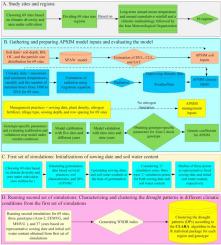European Journal of Agronomy ( IF 5.2 ) Pub Date : 2021-06-17 , DOI: 10.1016/j.eja.2021.126333 Sajjad Rahimi-Moghaddam , Reza Deihimfard , Khosro Azizi , Mozaffar Roostaei

|
Drought is considered one of the most common and challenging environmental stresses in the agricultural production worldwide. For improving the rainfed crop yields in the drought-prone environments, understanding the seasonal patterns of drought events in the target environments is crucial. This study applies the APSIM (Agricultural Production Systems sIMulator) crop model to interpret drought stress impact on a check genotype (early-maturity genotype) and mid- and late-maturity genotypes in 69 sites and 16 climate classes with climate data from over 37 years representing the rainfed wheat agro-ecosystems in Iran. Four drought patterns were recognized across the 16 regions. Water stress was dominant during grain filling (41 %) and around flowering (56 %) in studying regions. This stress varied over different genotypes and climate classes. Furthermore, results showed that under current management practices and using the check genotype, about half of the regions in the rainfed wheat agro-ecosystems of Iran (∼1.7 million ha) are frequently subject to severe drought patterns (50 %) resulting in a loss of grain yield of ∼2 t ha−1. Replacing a common genotype with an extra early-maturity genotype, however, reduced by 44 % the occurrence of severe drought patterns which simultaneously increased the occurrence of light-moderate drought stress (i.e. DP1 and DP2) in the warm regions. In general, planting the extra early-maturity genotype had the advantage of producing higher yields in the driest regions. Sowing this genotype reduced the variability in grain yield and the frequency of severe drought patterns in the warm regions. On the contrary, in rainy and cold regions, the best-yielding genotypes were those with a longer growth period. Therefore, in rainy and cold regions with light-moderate stress conditions, the breeders should focus on early-maturity and mid-maturity genotypes. Besides, it is suggested that the late-maturity genotype should be used in rainy regions with a reduced risk of drought stress.
中文翻译:

表征不同气候条件下雨养小麦 ( Triticum aestivum L.)干旱模式的时空趋势:建模方法
干旱被认为是全球农业生产中最常见和最具挑战性的环境压力之一。为了提高易干旱环境中的雨育作物产量,了解目标环境中干旱事件的季节性模式至关重要。本研究应用 APSIM(农业生产系统模拟器)作物模型来解释干旱胁迫对 69 个地点和 16 个气候类别中检查基因型(早熟基因型)和中晚熟基因型的影响,以及来自 37 年以上的气候数据代表伊朗的雨养小麦农业生态系统。在 16 个地区发现了四种干旱模式。在研究区域,灌浆期 (41%) 和开花前后 (56%) 水分胁迫占主导地位。这种压力因不同的基因型和气候等级而异。−1. 然而,用额外早熟基因型替换常见基因型,将严重干旱模式的发生率降低了 44%,同时增加了温暖地区轻度至中度干旱胁迫(即 DP1 和 DP2)的发生率。一般来说,种植超早熟基因型具有在最干旱地区产生更高产量的优势。播种这种基因型降低了温暖地区粮食产量的变异性和严重干旱模式的频率。相反,在多雨和寒冷地区,产量最好的基因型是那些生育期较长的基因型。因此,在轻中度胁迫条件下的多雨和寒冷地区,育种者应重点关注早熟和中熟基因型。除了,


























 京公网安备 11010802027423号
京公网安备 11010802027423号